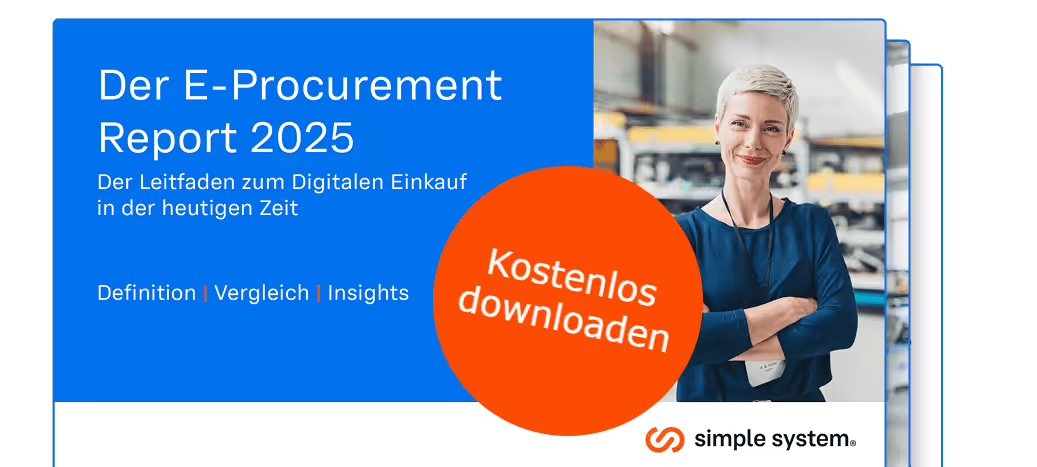Efficient Procurement for Companies: Digital, Transparent & Easy
Digital procurement is currently an indispensable undertaking in order to make processes in the purchasing department more efficient and to design and reduce costs at the same time.
Digital procurement is currently an indispensable undertaking in order to make processes in the purchasing department more efficient and to design and reduce costs at the same time. Smart solutions such as simple system simplify the procurement process immensely. They provide a central platform and easy automation of purchasing processes. Companies therefore benefit from reduced error rates, increased transparency and optimized cooperation with their suppliers. This not only makes procurement faster, but also more strategically valuable.
What is procurement, and why is it important?
Procurement comprises all processes for the procurement of products and services. It ranges from the needs assessment about the Selecting suppliers towards orders and supplier management. Efficient procurement is essential to optimize costs, ensure quality and ensure a reliable supply chain. In addition, strategic procurement helps to minimize risks, implement sustainable purchasing strategies and establish long-term partnerships with suppliers — a long-lasting boon for a company's competitiveness.
The role of the procurement manager
The Procurement Manager (also known as Purchasing Manager or Buyer) is responsible for strategic and operational activities in purchasing. He analyses requirements, selects suppliers and negotiates as well as optimizes purchasing processes. Its operational function serves cost reduction, Quality Assurance and ability to deliver in his department. The manager defines procurement strategies and monitors their implementation to eradicate supply chain delays and excess inventory. For optimal procurement planning, procurement managers or buyers should be sufficient professional experience to bring along.
Professional experience: What should a procurement manager bring with him?
A procurement manager should have solid experience in purchasing of material or services have. This includes comprehensive knowledge of Best Practices The receipt of goods is decisive — from checking the delivered goods for quality and completeness to efficient warehouse management. Equally important is a tailored to your needs and economic supply, which includes precise demand planning, close coordination with internal departments and the optimization of supplier strategies. The aim is to procure materials and services in the right quantity, at the right time and at optimal costs, with requirements varying depending on the sector — such as in construction companies or mechanical engineering.

Einkaufen & sparen
Erfahren Sie, wie es geht, in unserem kostenlosen E-Procurement-Report. Jetzt kostenlos und unverbindlich herunterladen.
Jetzt lesenProcurement process: The procurement process in detail
The procurement process can be broken down into nine steps.
- Needs assessment: detailed analysis of material and service requirements
- Market analysis: Identification of potential suppliers for the analysed requirements and evaluation of market conditions
- Selection of suppliers: Tenders, offer comparisons and selection of the best providers
- Price and contract negotiations: Ensuring optimal costs and contractual protection
- Order processing: Preparation and approval of orders and coordination with suppliers
- Receipt of goods & quality inspection: Control of delivery for quantity, quality, and compliance
- Payment processing: Audit, payment approval and accounting control
- Supplier management: Maintaining and evaluating supplier relationships for long-term optimization
- Controlling & optimization: Analysis of procurement processes to reduce costs and increase efficiency
Strategic importance of purchasing and procurement
Planning ahead is of paramount importance for both smaller and larger companies. It optimizes the expenses when purchasing materials thanks to long-term contracts and volume discounts. At the same time, he secures the quality in the company through the careful selection of suppliers and their evaluation. Thanks to diversification and stable partnerships, risks are minimized, which strengthens the company's competitive position. It is also possible to react more quickly to market changes in the industry — and at the right time.
Sustainable and ethical procurement practices increase this trust from customers and partners. By also effectively managing quality costs, companies can reduce overall costs and therefore increase customer satisfaction.
How does the e-procurement process work?
E-procurement digitizes procurement via electronic platforms (Procurement software). It enables clearly identifiable and automated processes — from demand planning to invoicing. Platforms such as simple system offer access to a broad network of suppliers and optimize the entire procurement process. They relieve buyers of manual operations and give them more freedom for strategic procurement management.
Benefits of automation in purchasing
Die electronic procurement provides companies with a variety of attractive benefits. Here are the most important benefits at a glance:
- Reduced process costs: Automation reduces costs for manual data entry, paperwork, and invoice processing. The result is a general reduction in costs.
- Minimized error rates: Accuracy and reliability in sales and distribution are significantly increased as manual entries and typing errors are eliminated.
- Expedited ordering processes: Automated systems enable faster orders, approvals, and deliveries. Turnaround times throughout the purchasing process are drastically reduced.
- Improved data analysis: procurement systems such as simple system provide comprehensive insights into spending and supplier performance, which enables well-founded decisions and strategic planning.
- Increased transparency: Automation provides a clear overview of all procurement activities. Traceability and compliance are thus significantly improved.
- Optimized supplier relationships: Digital platforms make it easier to communicate and collaborate with suppliers. As a result, companies enjoy stronger and more efficient partnerships.
Which trends are influencing the procurement industry?
Several key trends shape the procurement sector. They help companies more efficient, more sustainable and also more resilient to act. These developments are driving innovation and changing the way procurement — depending on the industry — is strategically designed.
Digitalization in purchasing
Digitalization represents purchasing through deployment of modernmodern technologies like predictive analytics and AI-based decision systems, completely upside down. The innovations optimize strategic purchasing processes. They also reduce costs and minimize risks in Supply chain management.
Predictive analytics enables precise price and demand forecasts. Companies recognize market trends early on and can adjust their purchasing strategies accordingly. The resulting optimized inventories, reduced costs and improved capital commitment are particularly beneficial. AI-based systems, on the other hand, automate unpleasant routine tasks. In addition to routine work, they analyse large amounts of data (big data) in real time. They identify potential savings, optimize relationships with suppliers and assist with price negotiations. Suppliers can also be integrated with digital platforms, making collaboration and transparency even better and easier.
The digital solutions increase purchasing efficiency by:
- Accelerated processes and reduced manual effort
- Improved transparency and traceability of procurement processes
- Optimized logistics Thanks to more Demand forecasts
- More effective Risk identification in the supply chain
Sustainability in procurement
Sustainable sourcing integrates environmental, social and economic criteria in the purchasing process. Companies are increasingly focusing on environmentally friendly materials, fair working conditions and energy-efficient processes. Especially when it comes to incoming goods, it is important that companies carefully check the origin of the raw materials to ensure that all criteria are met. By taking these factors into account, the brand image strengthened the company, which minimizes risks and results in long-term cost savings. Even in logistics, which often comprises several locations, these criteria must be observed in order to ensure efficient and sustainable added value. Companies thus secure a competitive advantage in dynamic markets and adapt to the economic situation — even in weaker economic periods.









